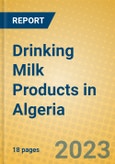Cow’s milk continues to dominate volume and value sales of drinking milk products in Algeria, with fresh milk accounting for the bulk of sales over shelf-stable milk in 2024. This dominance is attributed to the affordability of fresh milk, which is subsidised by Algerian authorities due to the notable drop in purchasing power and the increasing price sensitivity of consumers. Additionally, local consumers generally perceive fresh milk as more natural than shelf-stable offerings.
The Drinking Milk Products in Algeria report offers in-depth knowledge of the market at a national level, providing local insight and understanding unavailable elsewhere. In addition to the latest retail sales data 2019-2023, it identifies the leading companies, brands and retail outlets, and assesses the key trends and demographic shifts behind consumer demand and sales growth. How key trends such as health and wellness, sustainability and recovery from the pandemic are shaping the market directly informs our forecasts to 2028, clearly indicating how the market is expected to change.
Product coverage: Flavoured Milk Drinks, Milk, Powder Milk.
Data coverage: Market sizes (historic and forecasts), company shares, brand shares and distribution data.
The Drinking Milk Products in Algeria report offers in-depth knowledge of the market at a national level, providing local insight and understanding unavailable elsewhere. In addition to the latest retail sales data 2019-2023, it identifies the leading companies, brands and retail outlets, and assesses the key trends and demographic shifts behind consumer demand and sales growth. How key trends such as health and wellness, sustainability and recovery from the pandemic are shaping the market directly informs our forecasts to 2028, clearly indicating how the market is expected to change.
Product coverage: Flavoured Milk Drinks, Milk, Powder Milk.
Data coverage: Market sizes (historic and forecasts), company shares, brand shares and distribution data.
Why buy this report?
- Get a detailed picture of the Drinking Milk Products market
- Pinpoint growth sectors and identify factors driving change
- Understand the competitive environment, the market’s major players and leading brands
- Use five-year forecasts to assess how the market is predicted to develop.
Table of Contents
KEY DATA FINDINGSDAIRY PRODUCTS AND ALTERNATIVES IN ALGERIADISCLAIMER
2024 DEVELOPMENTS
PROSPECTS AND OPPORTUNITIES
CATEGORY DATA
EXECUTIVE SUMMARY
MARKET DATA
SOURCES








